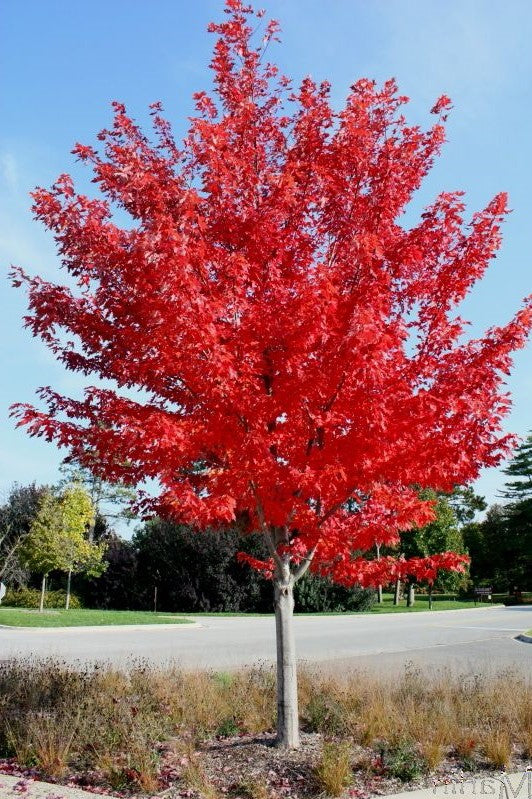by Ken Lain, the mountain gardener

The extreme growth of 3 feet or more each year. The fall color glows like embers in a blazing hot fire, thus the name. There is no better maple to plant in Arizona. It loves mountain soil, extreme conditions, and takes wind better than all other shade trees. Perfect for patios, hot sunny walls, street, and driveway trees or anyplace shaded relief is needed.
Autumn Blaze maple trees boast both beautiful fall foliage and a shapely form. The branching pattern is dense and ascending, and they sport a rounded to oval crown. Maturity comes quickly.
Botanical Name Acer x freemanii (Jeffersred)
Common Name Prescott Blaze Maple, Autumn Blaze tree
Plant Type Deciduous tree
Mature Size 35 feet tall x 30 feet wide
Sun Exposure 6+ hours of sun
Soil Type Moist, well-drained, and of average fertility
Soil pH 6 to 8 pH
Bloom Time No flowers
Flower Color No flowers
Hardiness Zones 3 to 8
Native Area North America
How to Grow Autumn Blaze Maple Trees
These plants need little care. Keep the soil around their roots moist while young. Water once per week while leaves are on the tree. Rarely is pruning required. Prune in late winter and spring if needed. March is ideal.
Light
In the mountains, this Maple prefers 6+ hours of sun. The more sun equals more leaves with better Autumn color.
Soil
This Maple prefers well-drained soil. Test the planting hole by filling it with water in the morning. If water is still pooling in the dug hole at the end of the day, you have drainage issues that will need more work.
Water newly planted trees regularly with a garden hose for at least one month (2 months in Summer). Automatic irrigation systems may not be sufficient initially. Water frequency will vary according to season, exposure and plant size.
April – Oct this Maple should be irrigated 2 x weekly
Nov – Mar this Maple should be irrigated 2 x monthly
Feed 4x Times per Year with either 7-4-4 All Purpose Plant Food, Soil Sulfur, or Humic. Here’s the recommendation by season:
Spring = 7-4-4 All Purpose Food + Soil Sulfur
Summer = 7-4-4 All Purpose Food + Humic
September = 7-4-4 All Purpose Food
December = 7-4-4 All Purpose Food
Other Maple Trees
Autumn Blaze maple is a hybrid of the red Maple (Acer rubrum) and the silver Maple (Acer saccharinum). There are many other popular Acer rubrum hybrids, all of which give have splendid autumn reds.
Red Sunset, October Glory, and Autumn Flame Maples each have a mature size similar to Autumn Blaze.
Armstrong Maple grows a bit taller, up to 60′ feet, but not at wide 15′ feed, giving this shade tree a distinctly columnar shape.
Autumn Blaze, Benefits, Drawback
Autumn Blaze maples can function in the landscape as fast-growing shade trees and specimens valued for fall foliage. Winner of back to back “Urban Tree of the Year” awards, this Maple is pollution-tolerant. They can adapt to a wide range of soil conditions and are both insect-resistant and disease-resistant.
These are outstanding fall foliage specimens. Their fast-growing nature and beauty in fall ensure them a place among the best landscape trees, along with Red Sunset and October Glory, which also have their champions.
The only drawback that Autumn Blaze maple is the shallow roots. This is a great trait that adapts to rocky soil, but these roots can stick up out of a lawn over time.
Other Choices With Colorful Fall Leaves
Sumac is one of the shortest fall-foliage standouts. It is classified as a shrub, although staghorn sumac, Rhus typhina, can grow to be 12′ tall and rather tree-like. Sumac shrub also tends to be one of the first plants in autumn to assume its fall foliage.
Oaks and Beech tend to be two of the tardiest in putting on their fall colors.
Sweetgum trees and Liquidambar trees also wait to show fall color until November.
Ginkgo biloba show in aspen gold at the same time as the red of Autumn Blaze Maples.

